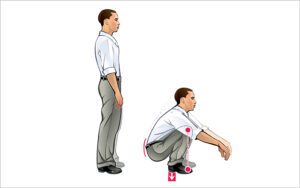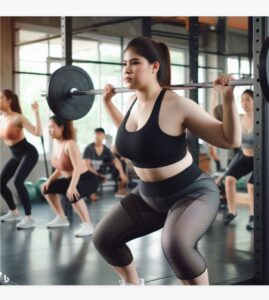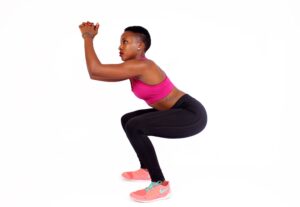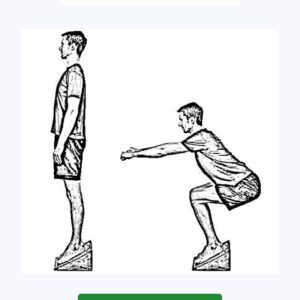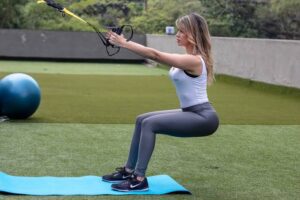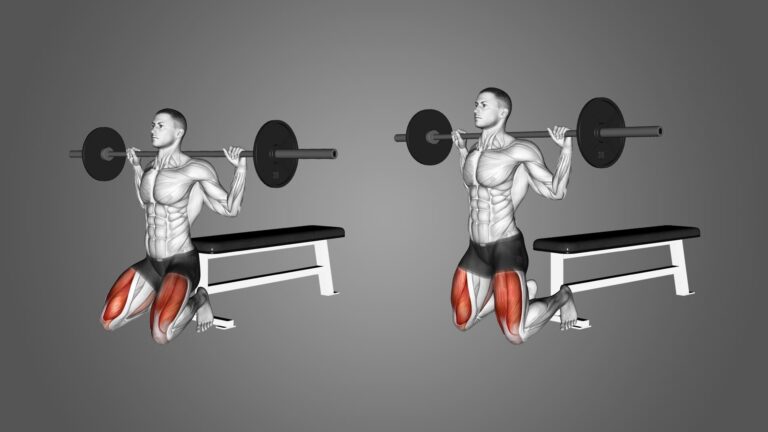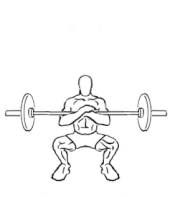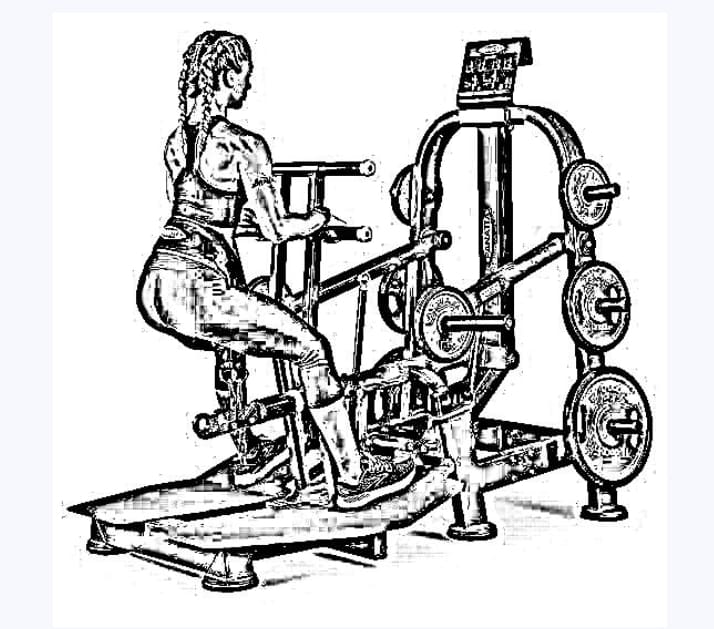
Belt squats, a unique variation of the traditional squat, offer a distinct set of benefits, making them an invaluable tool for those seeking to elevate their fitness journey. Unlike traditional squats, which place the weight directly on the back, belt squats distribute the load evenly across the hips and lower body, utilizing a weighted belt that secures around the waist, allowing for a more controlled and targeted workout.
In this article, we will explore the 12 proven benefits of belt squats and how they provide each of these benefits. The benefits of performing belt squats includes:
1. Greater Quadriceps Activation
One of the primary benefits of belt squats is their ability to target and activate the quadriceps muscles effectively. By removing the load from the spine and shoulders, belt squats allow for a more direct focus on the quadriceps. The exercise involves a deep squatting motion, which engages the quads throughout the entire range of motion, leading to increased muscle activation and growth.
2. Reduced Lower Back Strain
Traditional barbell squats can put a significant amount of stress on the lower back, especially for individuals with pre-existing back issues. Belt squats offer a safer alternative by removing the load from the spine and placing it on the hips and legs. This reduces the strain on the lower back, making it an excellent option for individuals with lower back pain or injuries.
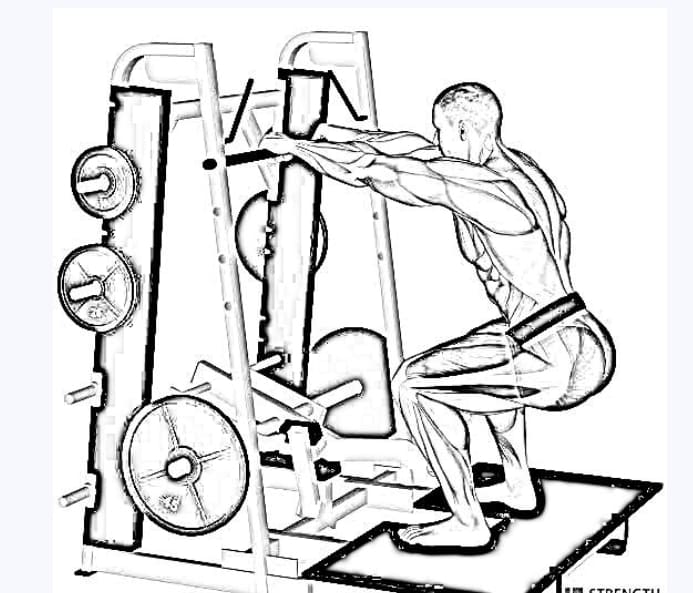
3. Improved Hip Mobility
Belt squats require a wider stance compared to traditional squats, which helps improve hip mobility. The exercise promotes hip abduction and external rotation, leading to increased flexibility and range of motion in the hip joint. This improved hip mobility can benefit athletes, powerlifters, and individuals looking to enhance their overall functional fitness.
4. Increased Glute Activation
While traditional squats also engage the glute muscles, belt squats can target the glutes even more effectively. By allowing the hips to move more freely and placing the load directly on the glutes, belt squats can lead to increased glute activation and development. This makes it an excellent exercise for individuals looking to strengthen and tone their glute muscles.
5. Enhanced Core Stability
Core stability is crucial for maintaining proper form and posture during any exercise. Belt squats require a strong and stable core to support the load and maintain balance throughout the movement. By engaging the core muscles, including the rectus abdominis, obliques, and erector spinae, belt squats can improve overall core stability and strength.
6. Joint-Friendly Exercise
For individuals with joint issues or those recovering from injuries, belt squats offer a joint-friendly alternative to traditional squats. By removing the load from the spine, knees, and ankles, belt squats reduce the impact on these joints, making it a suitable exercise for individuals with arthritis, knee pain, or other joint-related problems.
7. Improved Balance and Coordination
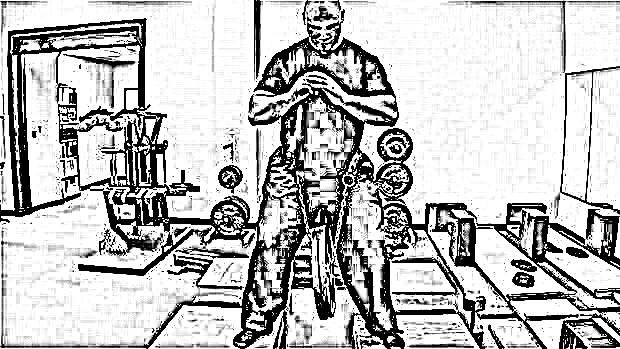
Belt squats require a certain level of balance and coordination to perform correctly. The exercise challenges the body’s ability to maintain stability and control throughout the movement. By incorporating belt squats into your training routine, you can enhance your balance and coordination, which can translate into improved performance in other activities and sports.
8. Versatile Exercise Variation
Belt squats offer a wide range of exercise variations that can target different muscle groups and provide variety in your training routine. You can perform belt squats with a variety of stances, such as narrow, wide, or sumo, to emphasize different muscle groups. Additionally, you can incorporate other equipment, such as resistance bands or chains, to increase the intensity and challenge of the exercise.
9. Increased Quadriceps and Glute Strength
Due to the targeted nature of belt squats, they can lead to significant strength gains in the quadriceps and glute muscles. By consistently incorporating belt squats into your training routine and progressively increasing the load, you can build stronger and more powerful lower body muscles. This increased strength can improve athletic performance and overall functional fitness.
10. Effective Rehabilitation Exercise
Belt squats can be a beneficial exercise for individuals undergoing rehabilitation or recovering from lower body injuries. The exercise allows for controlled and targeted strengthening of the lower body muscles without placing excessive stress on the injured area. It can help improve muscle imbalances, joint stability, and range of motion during the recovery process.
11. Accessible for All Fitness Levels
Whether you are a beginner or an advanced fitness enthusiast, belt squats can be adapted to suit your fitness level. The exercise allows for easy load adjustments by adding or removing weight plates or adjusting the resistance bands. This accessibility makes it a valuable exercise for individuals of all fitness levels, from beginners to elite athletes.
12. Efficient Lower Body Workout
Belt squats provide a highly efficient lower body workout that targets multiple muscle groups simultaneously. By engaging the quadriceps, glutes, hamstrings, and core muscles, belt squats offer a comprehensive lower body workout in a single exercise. This efficiency can save time and provide maximum results in terms of muscle activation and strength development.
Belt squats offer numerous benefits for individuals looking to improve their lower body strength, enhance their overall fitness level, and target specific muscle groups. From greater quadriceps activation and reduced lower back strain to improved hip mobility and increased glute activation, belt squats provide a versatile and effective exercise option.

Incorporating belt squats into your workout routine guarantees you will enjoy all the benefits mentioned above. Here’s a simple guide to incorporating belt squats for maximum benefits:
1. Proper Form and Technique:
- Starting Position: Stand with feet shoulder-width apart, toes slightly pointed out. Secure the belt around your waist, ensuring it’s snug but not too tight.
- Squat Position: Lower your body into a squat position, maintaining a straight back, engaged core, and knees aligned with your toes. Avoid rounding your back or allowing your knees to collapse inward.
- Bar Path: As you lower yourself, keep the bar path straight, traveling vertically from your shoulders to your hips. This ensures proper engagement of the target muscle groups.
- Range of Motion: Squat down until your thighs are parallel to the ground. Avoid squatting too low, which can put unnecessary strain on your knees.
- Standing Phase: Drive through your heels to stand back up, maintaining proper form throughout the movement.
2. Warm-up and Cool-down:
- Warm-up: Before starting belt squats, perform a dynamic warm-up to prepare your muscles and joints. This could include light cardio, bodyweight squats, and leg swings.
- Cool-down: After completing your belt squat sets, perform a static cool-down to promote recovery and reduce muscle soreness. This could include hamstring stretches, quad stretches, and calf stretches.
3. Exercise Variations:
- Wide Stance Belt Squats: This variation places more emphasis on the glutes and hamstrings.
- Narrow Stance Belt Squats: This variation emphasizes the quadriceps and inner thighs.
- Deficit Belt Squats: This variation challenges the ankle mobility and increases the range of motion.
- Elevated Heel Belt Squats: This variation places more emphasis on the hamstrings and calves.
- Box Belt Squats: This variation provides a target depth for the squat, reducing the risk of overtraining.
4. Programming and Progression:
- Start with Light Weight and Gradually Increase: Begin with a weight that allows you to maintain proper form throughout the movement. As you get stronger, gradually increase the weight to challenge your muscles.
- Incorporate 2-3 Sets of 8-12 Repetitions: Aim for 2-3 sets of 8-12 repetitions per exercise variation. This range allows for sufficient muscle stimulation and adaptation.
- Rest Adequately Between Sets: Allow 30-60 seconds of rest between sets to allow your muscles to recover and maintain proper form throughout the workout.
- Incorporate Belt Squats into Your Routine 2-3 Times per Week: Aim to perform belt squats 2-3 times per week to allow for muscle growth and strength gains.
As you get stronger, you can gradually increase the weight you use or the number of repetitions you perform. You can also try using a lower box to challenge yourself further.
5. Safety Considerations:
- Avoid Excessive Forward Lean: Maintain a neutral spine and avoid excessive forward lean during the squat, as this can place undue stress on your lower back.
- Keep Your Knees Aligned: Ensure your knees are aligned with your toes throughout the squat to prevent knee pain or injury.
- Use Proper Weight: Use a weight that allows you to maintain proper form throughout the movement. Avoid lifting too heavy a weight, which can compromise form and increase the risk of injury.
- Listen to Your Body: If you experience any pain or discomfort during the exercise, stop and consult a healthcare professional before continuing.
6. Common mistakes to avoid:
Certainly, here are a few common mistakes often observed in belt squats:
- Incorrect Belt Placement: Placing the belt too high or too low on the waist can impact the exercise’s effectiveness and compromise the intended muscle engagement.
- Improper Weight Distribution: Failing to evenly distribute weight while suspended in the belt can lead to instability and inadequate activation of targeted muscles.
- Overestimating or Underestimating Weight: Using excessive or insufficient weight can impact the exercise’s efficacy, potentially leading to improper form and reduced benefits.
- Ignoring Proper Form: Neglecting to maintain correct squatting form, such as bending the knees too far forward or rounding the back, can increase the risk of injury and diminish the exercise’s effectiveness.
- Lack of Core Engagement: Failing to engage the core muscles while performing belt squats can lead to instability and reduce the exercise’s effectiveness in targeting lower body muscles.
By following these guidelines, you can effectively incorporate belt squats into your workout routine and reap the many benefits they offer for enhanced lower body strength, stability, and overall athletic performance. Remember to prioritize proper form, warm-up, cool-down, and gradual progression to maximize benefits and minimize the risk of injury.
Whether you’re a beginner or an advanced fitness enthusiast, incorporating belt squats into your training routine can lead to significant improvements in strength, stability, and overall functional fitness. So, grab a belt or harness, find a weight stack or resistance band, and start reaping the benefits of belt squats today!
Related Posts
Reference:
[1] https://barbend.com/hip-belt-squat/
[2] https://www.bellsofsteel.us/blog/gear-education/is-the-belt-squat-worth-it/
[3] https://central.gymshark.com/article/how-to-use-the-belt-squat-machine-and-exercise-benefits
[4] https://www.reddit.com/r/naturalbodybuilding/comments/twte40/belt_squat_vs_barbell_highlow_squat/
[5] https://www.ncbi.nlm.nih.gov/pmc/articles/PMC7126258/
[6] https://kustomkitgymequipment.com/blogs/news/hip-belt-squat-the-ultimate-leg-machine/







